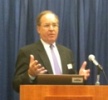Minute holes in the soles of the footwear are the biggest area of concern in the protection scenarios.
OSHA opened its inspection of A.C. Castle Construction upon observing employees working without fall protection on the building's roof and on a ladder jack scaffold, exposing them to falls of nearly 19 feet.
The British Safety Industry Federation warns that buyers can be confused by a "CE" mark that is not representing true approval.

The new document is sure to help employers because it lists and links to the standards that require them to provide PPE and links to a list of relevant OSHA interpretation letters.
The directive recognizes updated consensus standards and includes more information about the PPE shipyard employers must provide to workers at no cost, as well as PPE for which they don't have to pay.

Two units of the federal Technical Support Working Group are hosting PPE Conference 2010 in Fort Lauderdale, Fla., Nov. 30-Dec. 3. TSWG is the interagency R&D anti-terrorism program.
Companies can use it to assess their needs for various types of protective equipment, from head to toe, based on a hazard assessment.

Mark Levy, president of the Honeywell Life Safety business, says the acquisition completed Sept. 15 positions its 17,000 worldwide employees well for a global market where safety standards are quickly rising.

Sixteen companies win top honors in the magazine's second annual contest, with trophies and ribbons handed out Tuesday at the National Safety Council Congress & Expo in San Diego.
“Sperian Protection is an excellent fit for Honeywell,” said Mark S. Levy, president and CEO of Honeywell Life Safety. “With highly developed product lines, well-recognized brands, and a strong global distribution channel, Sperian complements and significantly strengthens Honeywell’s position in the personal protective equipment segment.

"Employees forget, don't care, get uncomfortable, and take it off at break or lunch. My job is to keep them safe from themselves all day."
In the same way the demand for respirators challenged manufacturers after H1N1 influenza was declared a pandemic, glove and apparel orders soared once the spill began.
Workers and safety managers increasingly seek footwear that provides metatarsal protection. Safety toe is still on top in sales, however.
The worker was fatally electrocuted when he grabbed the test leads on a shop-made cart the company used during the testing process of equipment the company manufactures.

The agency is seeking comment on, among other things, whether it should include an explicit reference to combustible dust or other hazardous material in the regulatory language of the final rule.

The latest semiannual regulatory agenda does not advance the rulemaking except to give an October 2010 date to complete analyzing comments submitted in 2008. EPA's agenda says NPRMs will be issued in July 2011 to enhance pesticide protection for applicators and agricultural workers.
"Get a grip: Stop slips & trips" includes a comprehensive checklist and advises users to remember the acronym SHOES for Spills, High-risk areas, Over-used signs, Environmental cleanliness, and Shoes.

Manufacturing a protective boot that can meet exacting national standards is challenging enough. When the relevant industry adds its own performance testing to the mix, as the aluminum smelter industry around the world has done, the challenge grows — but this happens for all the right reasons.

The International Apparel Federation and two allied organizations have organized a conference Tuesday in Paris about product safety and chemical safety regulations in the United States and the European Union, while, outside, the big Texworld 2010 conference takes place.
Breakout sessions during the March 2-3 stakeholder meeting in Pittsburgh will detail current research on protective clothing performance and help NIOSH do better at warning end users about counterfeit respirators. Dr. John Howard will be the keynote speaker.